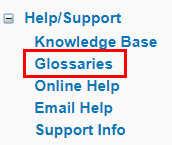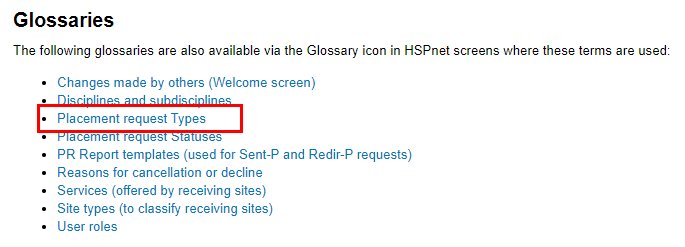Glossary - Placement Request Types
On January 1st, 2025 the list of Placement Request Types available for all placements in HSPnet will be updated. Any changes to placement requests after that date will only be possible using the new list of types. Past placements will keep the existing types entered historically and these types will be available in reports for those placements.
Why are the placement types changing?
A national working group, comprised from members of the HSPnet National Alliance, extensively reviewed and edited the placement types that HSPnet users choose when setting up courses and creating placement requests. A number of the current placement request types are viewed as ambiguous, and may have had overlapping definitions, or were not as clear and concise as they could be. This revised list of placement request types were focus-tested in all provinces using HSPnet in 2024. Feedback from the provincial focus groups was reviewed and final edits made to arrive at the new list and definitions.
How will the changes affect me?
Starting on January 1, 2025, the list of placement request types available in the course setup and placement request detail screens will show the revised list of reasons, along with definitions of how they are intended to be used. No historical data is being updated. Any new placement requests or changes to existing placements will use the new list of reasons. Placement requests created or modified prior to January 1, 2025 will retain the placement type selected from the previous list. These previous placement types along with the new ones will appear in reports of placement requests.
Watch the Q&A on Revisions to Placement Request Types webinar
Revised Placement Request Type Glossary (effective January 1, 2025)
The following definitions for each Request Type category in HSPnet are provided to guide users. The definitions are offered as a reference only within HSPnet, and are not intended to replace or contradict definitions of these terms that may be used elsewhere.
|
Request Type Long name (Short name) |
Definition |
Example/Scenario
|
Mapping for original Placement Request Types |
|
Individual (Indiv) |
One student from a Placing Agency (PA) program who is supported by one or more employee/contractor(s) of the Receiving site. The focus of the placement is direct client services or services that support patient care. Other terms: preceptorship, fieldwork, internship, practice education or mentorship. |
A school is requesting a placement for an individual student at a hospital. The student would be directly supervised by a staff that is employed by the Receiving Agency (RA) Site. The RA staff also contribute to the student evaluations. |
Preceptor Mentor Fieldwork Internship Practice Education Clinical Placement |
|
Project (Proj) |
One or more students from a PA program who are supported by an employee/contractor of the Receiving site. The focus of the placement is activities/deliverables such as leadership, quality improvement, program development, research, analysis, etc. This placement has no direct patient care. |
A school is requesting a placement for a pharmacy student at a hospital pharmacy to work on a research project. |
Project Field/Proj |
|
Group (Instructor Led) (Group) |
More than one student from a PA program who are supported by an employee/contractor of the PA. During the placement, the PA employee/contractor is on-site for the duration of the placement. The focus of the placement is direct client services. |
A school is requesting a placement for a group of students at an agency. The group would be fully supervised while on site by their instructor, who is employed by the school. |
|
|
Shared Supervision Group (SharedSupervGrp) |
More than one student from a PA program who are supported by an employee/contractor of the PA who is providing both direct and remote supervision. While the PA employee/contractor is off-site, the students are supported by an employee/contractor(s) from the Receiving site. This PR should be used when there is a prior, mutual arrangement between PA & RA destination and the manner and level of the shared supervision should be pre-determined by the PA and RA. The focus of the placement is direct client services. |
A school is requesting a placement at a healthcare agency. This placement can be a group or a preceptorship. The student(s) would have shared supervision on site between a staff employed by the healthcare agency and a personnel (e.g.; instructor) employed by the school. |
Grp/Field |
|
Observation (Observ) |
One or more students enrolled in a PA program, or independent learners who are supported by an employee/contractor(s) from the Receiving site. The focus of the placement is observation only and learners do not provide any hands on or direct client services (including but not limited to: assessment, treatment/intervention, education, or counselling). Other terms: Site/Destination Tours, Job Shadow, Career Observation. |
Example A: A school is requesting one student out of a group placed at another destination to attend an ambulatory care clinic for a day.
Example B: A school is requesting a placement for an individual student, who is completing a placement at a medicine unit, to observe for a single shift at a community diabetic clinic.
Example C: An Occupational Therapy program is requesting a series of observation experiences for their individual student or group of students in a rehabilitation facility. |
|
|
eOrientation (eOPE) |
eOPE preparation for upcoming placement: Used internally by PA to track the progress of students completing the eOPE modules before a placement. |
Only used by provinces that use the E-Orientation function in HSPnet. |
|
|
Simulation Practicum (SimulPract) |
More than one student supported by an employee/contractor of the PA or RA in a simulated environment for the learning activities. The focus of the placement is to simulate direct client services.
|
Example A: A university skills lab is providing practice experiences for their students to obtain clinical hours towards the student’s graduation requirements. The school is using HSPnet to track these hours.
Example B: A hospital simulation lab is providing clinical experiences for students in an educational program while they are at the clinical site. |
|
|
Virtual Practice (Virtual) |
One or more students from a PA program who are supported by an employee/contractor from the RA. The focus of the placement relies on delivering direct client services virtually using digital technologies.
|
Example A: A unit clerk program is requesting a placement attending client intake telephone lines.
Example B: A nursing program is requesting a placement with an 811 nursing helpline.
Example C: A nurse practitioner program is requesting a placement with a virtual post discharge program. |
|
|
Supervised Practice (SupervPract) |
One learner not enrolled in a PA program who is supported by an employee/contractor from the Receiving site. The focus of the placement is direct client services. |
Example A: A Canadian trained RN, whose license to practice has expired requires 300 supervised clinical unpaid hours through a provincial nursing regulating body as an independent learner.
Example B: An internationally educated health professional requires unpaid supervised practice hours to obtain their license to practice in Canada. |
SuperPrac |
|
Funded Placement (FundPlace) |
One student in a PA education program/work placement where the student receives some form of remuneration from the RA for the placement. The student is supported by an employee/contractor from the Receiving site. The focus of the placement is direct client services. |
A BSN student currently completing their degree is placed at a rural hospital and is receiving funding from the Receiving Agency to complete their clinical placement. |
|
|
Staff Learning (StaffLearn) |
One or more staff who are participating in RA-led learning and are supported by an employee/contractor from the RA. The purpose of this form of placement is to allow for the tracking of hours and supervision of RA employee learning. |
A hospital staff member working at the emergency room attends a disaster response training course organized by their employer. |
StaffLearn Work |
|
Residency (Residency) |
One learner in a residency program who is supported by one or more employee/contractor(s) from the PA or Receiving site. The focus of the placement is direct client services. |
A medical resident is completing a rotation at a hospital medicine inpatient unit. |
EmpResidency |
Existing Placement Request Type definitions used province-by-province are available in the inline HSPnet glossaries in each province. Go to HSPnet and look in the left navigation bar under Help/Support and click Glossaries.
When that opens up, click Placement request Types to open that glossary.


